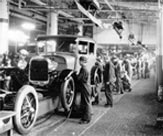Alan Mulally, President & CEO, talks about Ford's New Vision
Gas Prices
We Call This “The Power of Choice”
And, we can only offer the power of choice to consumers if we have a vibrant, competitive manufacturing base. In today’s world, rising gas prices are a fact of life. That’s why Ford decided to invest heavily in developing fuel-efficient technologies and create a more balanced vehicle portfolio that better positions us to address consumers’ shifting demands. Further, to build these new vehicles and technologies, Ford has transformed two of its North America truck plants to small car plants and we are in the process of converting our third facility.
Fuel Economy Equals Job Growth
At our Michigan Assembly Plant in Wayne, Mich., for example, we have spent more than $550 million to transform the facility from one that built large trucks and SUVs to one that produces the new Ford Focus, which achieves 40 mpg. The plant’s new product lineup includes not only the gas-powered Focus, but a Battery Electric Focus, a C-MAX hybrid and the C-MAX Energi plug-in hybrid will be built there as well. It will be the first facility in the world capable of building this range of powertrain offerings on the same assembly line.
Ford currently builds 12 vehicles that offer best-in-class fuel economy — four models that get at least 40 mpg. No other full-line automaker can make that statement. Fuel efficiency is a key reason more buyers are considering Ford cars and trucks these days. It’s a key reason our sales increased 19 percent in 2010 and our market share grew for a second straight year. And it’s a key reason Ford ranks first on new-vehicle shoppers’ consideration lists, according to the latest Market Intelligence Brand Watch study from Kelley Blue Book.
We have devoted billions to researching, developing and producing new fuel-efficient products, engines, and transmissions — as well as electrified vehicles. While some of our competitors cut R&D spending during the downturn, we kept investing in the future. For example, we have developed and brought to market the EcoBoost engine that delivers up to 20 percent better fuel economy with 15 percent fewer CO2 emissions and superior driving performance versus larger-displacement engines. By 2013, we expect to produce 1.5 million EcoBoost engines globally — making that engine available in 80 percent of our global nameplates and 90 percent of our North American nameplates.
And we are dedicated to continually developing new powertrains, as well as innovating in aerodynamics and light-weighting.
Fuel economy has become a paramount concern for consumers when weighing a vehicle purchase. At Ford, we are committed to building vehicles that rank among the best in fuel economy — but do not sacrifice performance, capability or drivability. We strive for this goal with every new product we bring to market.







